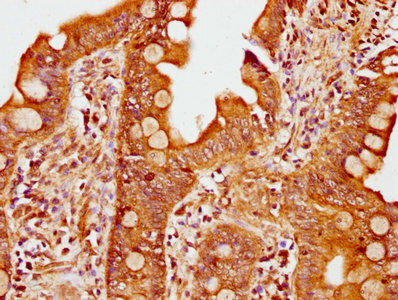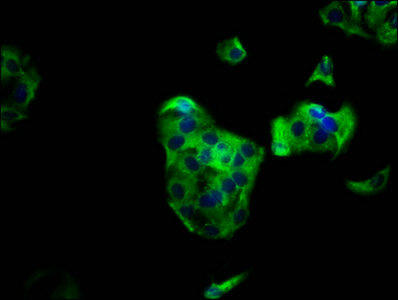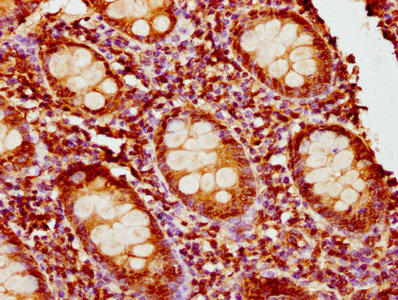Description
| Antibody Name: | PIK3R6 Antibody (PACO60997) |
| Antibody SKU: | PACO60997 |
| Size: | 50ug |
| Host Species: | Rabbit |
| Tested Applications: | ELISA, WB, IHC, IF |
| Recommended Dilutions: | ELISA:1:2000-1:10000, WB:1:500-1:5000, IHC:1:200-1:500, IF:1:50-1:200 |
| Species Reactivity: | Human |
| Immunogen: | Recombinant Human Phosphoinositide 3-kinase regulatory subunit 6 protein (566-667AA) |
| Form: | Liquid |
| Storage Buffer: | Preservative: 0.03% Proclin 300 Constituents: 50% Glycerol, 0.01M PBS, pH 7.4 |
| Purification Method: | >95%, Protein G purified |
| Clonality: | Polyclonal |
| Isotype: | IgG |
| Conjugate: | Non-conjugated |
 | IHC image of PACO60997 diluted at 1:400 and staining in paraffin-embedded human small intestine tissue performed on a Leica BondTM system. After dewaxing and hydration, antigen retrieval was mediated by high pressure in a citrate buffer (pH 6.0). Section was blocked with 10% normal goat serum 30min at RT. Then primary antibody (1% BSA) was incubated at 4°C overnight. The primary is detected by a biotinylated secondary antibody and visualized using an HRP conjugated SP system. |
 | Immunofluorescence staining of HepG2 cells with PACO60997 at 1:133, counter-stained with DAPI. The cells were fixed in 4% formaldehyde, permeabilized using 0.2% Triton X-100 and blocked in 10% normal Goat Serum. The cells were then incubated with the antibody overnight at 4°C. The secondary antibody was Alexa Fluor 488-congugated AffiniPure Goat Anti-Rabbit IgG(H+L). |
 | IHC image of PACO60997 diluted at 1:400 and staining in paraffin-embedded human appendix tissue performed on a Leica BondTM system. After dewaxing and hydration, antigen retrieval was mediated by high pressure in a citrate buffer (pH 6.0). Section was blocked with 10% normal goat serum 30min at RT. Then primary antibody (1% BSA) was incubated at 4°C overnight. The primary is detected by a biotinylated secondary antibody and visualized using an HRP conjugated SP system. |
| Background: | Regulatory subunit of the PI3K γ complex. Acts as an adapter to drive activation of PIK3CG by beta-γ G protein dimers. The PIK3CG:PIK3R6 heterodimer is much less sensitive to beta-γ G protein dimers than PIK3CG:PIK3R5 and its membrane recruitment and beta-γ G protein dimer-dependent activation requires HRAS bound to PIK3CG. Recruits of the PI3K γ complex to a PDE3B:RAPGEF3 signaling complex involved in angiogenesis; signaling seems to involve RRAS. |
| Synonyms: | Phosphoinositide 3-kinase regulatory subunit 6 (Phosphoinositide 3-kinase γ adapter protein of 87 kDa) (p84 PI3K adapter protein) (p84 PIKAP) (p87 PI3K adapter protein) (p87PIKAP), PIK3R6, C17orf38 |
| UniProt Protein Function: | PIK3R6: Regulatory subunit of the PI3K gamma complex. Acts as an adapter to drive activation of PIK3CG by beta-gamma G protein dimers. The PIK3CG:PIK3R6 heterodimer is much less sensitive to beta-gamma G protein dimers than PIK3CG:PIK3R5 and its membrane recruitment and beta-gamma G protein dimer-dependent activation requires HRAS1 bound to PIK3CG. Recruits of the PI3K gamma complex to a PDE3B:RAPGEF3 signaling complex involved in angiogenesis; signaling seems to involve RRAS.Chromosomal Location of Human Ortholog: 17p13.1Cellular Component: cytosol; membrane; phosphoinositide 3-kinase complex; plasma membraneMolecular Function: 1-phosphatidylinositol-3-kinase regulator activity; phosphatidylinositol-4,5-bisphosphate 3-kinase activity; protein bindingBiological Process: angiogenesis; G-protein coupled receptor signaling pathway; phosphatidylinositol biosynthetic process; phosphatidylinositol phosphorylation; phosphoinositide 3-kinase cascade; platelet activation; positive regulation of angiogenesis; positive regulation of MAP kinase activity; positive regulation of T cell differentiation; regulation of natural killer cell mediated cytotoxicity; regulation of phosphoinositide 3-kinase activity |
| UniProt Protein Details: | |
| NCBI Summary: | Phosphoinositide 3-kinase gamma is a lipid kinase that produces the lipid second messenger phosphatidylinositol 3,4,5-trisphosphate. The kinase is composed of a catalytic subunit and one of several regulatory subunits, and is chiefly activated by G protein-coupled receptors. This gene encodes a regulatory subunit, and is distantly related to the phosphoinositide-3-kinase, regulatory subunit 5 gene which is located adjacent to this gene on chromosome 7. The orthologous protein in the mouse binds to both the catalytic subunit and to G(beta/gamma), and mediates activation of the kinase subunit downstream of G protein-coupled receptors. Alternative splicing results in multiple transcript variants. [provided by RefSeq, Feb 2014] |
| UniProt Code: | Q5UE93 |
| NCBI GenInfo Identifier: | 58082081 |
| NCBI Gene ID: | 146850 |
| NCBI Accession: | NP_001010855.1 |
| UniProt Secondary Accession: | Q5UE93 |
| UniProt Related Accession: | Q5UE93 |
| Molecular Weight: | |
| NCBI Full Name: | phosphoinositide 3-kinase regulatory subunit 6 isoform 1 |
| NCBI Synonym Full Names: | phosphoinositide-3-kinase regulatory subunit 6 |
| NCBI Official Symbol: | PIK3R6 |
| NCBI Official Synonym Symbols: | C17orf38; HsT41028; p87PIKAP; p84 PIKAP; p87(PIKAP) |
| NCBI Protein Information: | phosphoinositide 3-kinase regulatory subunit 6 |
| UniProt Protein Name: | Phosphoinositide 3-kinase regulatory subunit 6 |
| UniProt Synonym Protein Names: | Phosphoinositide 3-kinase gamma adapter protein of 87 kDa; p84 PI3K adapter protein; p84 PIKAP; p87 PI3K adapter protein; p87PIKAP |
| Protein Family: | |
| UniProt Gene Name: | PIK3R6 |
| UniProt Entry Name: |






